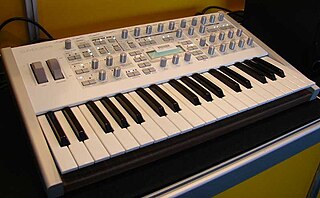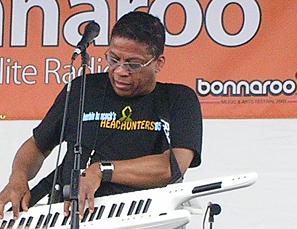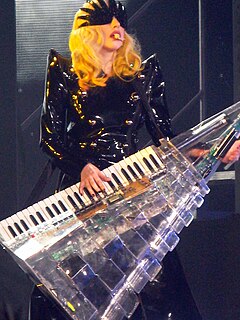
The Synclavier was an early digital synthesizer, polyphonic digital sampling system, and music workstation manufactured by New England Digital Corporation of Norwich, Vermont. It was produced in various forms from the late 1970s into the early 1990s. The instrument has been used by prominent musicians.

A keyboardist or keyboard player is a musician who plays keyboard instruments. Until the early 1960s musicians who played keyboards were generally classified as either pianists or organists. Since the mid-1960s, a plethora of new musical instruments with keyboards have come into common usage, requiring a more general term for a person who plays them. These keyboards include:

Jordan Rudess is an American keyboardist and composer best known as a member of the progressive metal/rock band Dream Theater and the progressive rock supergroup Liquid Tension Experiment.

The Roland SH-101 is an analog synthesizer manufactured by the Roland Corporation between 1982 and 1986. Though it was a commercial failure, it became a staple of electronic music in the 1990s, particularly house music.

The Jupiter-8, or JP-8, is an eight-voice polyphonic analog subtractive synthesizer introduced by Roland Corporation in early 1981.

Henrik "Henkka" Klingenberg is a keyboardist, keytarist and singer. He joined the Finnish power metal band Sonata Arctica in late 2002 and currently resides in Kemi, Finland, when not on tour.

The Roland Corporation has manufactured several keytars.

The Roland AX-7 is a keytar that was manufactured by Roland Corporation from 2001 to 2007. This modern instrument contains many more advanced features than early keytars such as its predecessor, the Roland AX-1, and the Yamaha SHS-10. It runs on 6 AA batteries or an external power source. It has a 45 velocity sensitive keys, and a 3-character LED display. Several features aimed towards stage performance are present, such as a pitch bend ribbon, touchpad-like expression bar, sustain switch, and volume control knob, all on the upper neck of the instrument. There is also a proprietary "D-Beam" interface, made up of infrared sensors that detect nearby motion.
The Fantom-X (Xa/X6/X7/X8/XR) is a music workstation/synthesizer produced by Roland Corporation. It was introduced in 2004 as an upgrade from the Fantom S series. The Fantom-X competes with the Korg Triton/Triton Extreme, the Yamaha Motif ES and other similar large-scope keyboards such as the discontinued Alesis Fusion. In 2008 it was succeeded by the Fantom-G, which was devised to compete with the new Korg and Yamaha flagship keyboards.

A guitar synthesizer is any one of a number of musical instrument systems that allow a guitarist to access synthesizer capabilities.

The Yamaha MM6 is a compact synthesizer manufactured by the Yamaha Corporation, and was first introduced in January 2007. The MM6 includes fairly high quality samples for the price of the keyboard, however it is still a professional level piece of equipment. The default samples that is provided on board the MM6 are based on the Yamaha Motif series workstation sound sets. This keyboard comes with 418 patches, and 22 drum kits, all based upon those that available with the Motif series workstations.

The AX60 is a polyphonic analogue keyboard synthesizer manufactured by Akai Professional in the mid-1980s. It was Akai's answer to the popular Roland Juno series synthesizers. The AX60 uses voltage-controlled analogue oscillators and filter circuitry based on the Curtis Electronics CEM 3394 integrated circuit.
Vocaloid Keyboard is a physical MIDI keyboard with a built-in Vocaloid synthesizer. The commercial product as a keytar was released in December 2017.
The SH-01 Gaia, is a sixty four voice polyphonic virtual analogue synthesizer introduced by Roland Corporation in 2010.
The Jupiter-80 is a discontinued 256-voice polyphonic analog subtractive introduced by Roland Corporation in 2011. The Jupiter-80 is apart Roland's flagship long-running synthesizer series, which began with the Jupiter-4 between the years of 1978 and 1981. The Jupiter-80 was shortly followed by the Jupiter-50, which is a combination of both the JP-80 and the JUNO series.
The Jupiter-50 is a discontinued 256-voice polyphonic analog subtractive synthesizer introduced by Roland Corporation in 2011. The Jupiter-50 is apart Roland's flagship synthesizer series, which began with the Jupiter-4 between the years of 1978 and 1981. The Jupiter-50 is also considered a hybrid/combination of both the Jupiter-80 and the JUNO series.
The VK-8 Combo Organ is a discontinued electronic keyboard introduced in 2002, which simulates the sound of an electromechanical tonewheel-based Hammond organ. The VK-8 is both an improvement and successor to both the VK-7 and VK-77. The VK-8 itself was succeeded by the VK-88.













